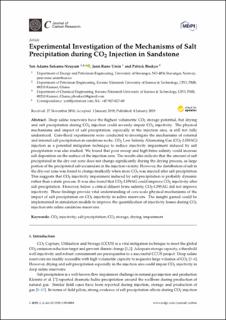| dc.contributor.author | Sokama-Neuyam, Yen Adams | |
| dc.contributor.author | Ursin, Jann Rune | |
| dc.contributor.author | Boakye, Patrick | |
| dc.date.accessioned | 2023-02-03T11:32:05Z | |
| dc.date.available | 2023-02-03T11:32:05Z | |
| dc.date.created | 2020-02-27T10:16:51Z | |
| dc.date.issued | 2019 | |
| dc.identifier.citation | Sokama-Neuyam, Y. A., Ursin, J. R., & Boakye, P. (2019). Experimental investigation of the mechanisms of salt precipitation during CO2 injection in sandstone. C, 5(1), 4. | en_US |
| dc.identifier.issn | 2311-5629 | |
| dc.identifier.uri | https://hdl.handle.net/11250/3048268 | |
| dc.description.abstract | Deep saline reservoirs have the highest volumetric CO2 storage potential, but drying and salt precipitation during CO2 injection could severely impair CO2 injectivity. The physical mechanisms and impact of salt precipitation, especially in the injection area, is still not fully understood. Core-flood experiments were conducted to investigate the mechanisms of external and internal salt precipitation in sandstone rocks. CO2 Low Salinity Alternating Gas (CO2-LSWAG) injection as a potential mitigation technique to reduce injectivity impairment induced by salt precipitation was also studied. We found that poor sweep and high brine salinity could increase salt deposition on the surface of the injection area. The results also indicate that the amount of salt precipitated in the dry-out zone does not change significantly during the drying process, as large portion of the precipitated salt accumulate in the injection vicinity. However, the distribution of salt in the dry-out zone was found to change markedly when more CO2 was injected after salt precipitation. This suggests that CO2 injectivity impairment induced by salt precipitation is probably dynamic rather than a static process. It was also found that CO2-LSWAG could improve CO2 injectivity after salt precipitation. However, below a critical diluent brine salinity, CO2-LSWAG did not improve injectivity. These findings provide vital understanding of core-scale physical mechanisms of the impact of salt precipitation on CO2 injectivity in saline reservoirs. The insight gained could be implemented in simulation models to improve the quantification of injectivity losses during CO2 injection into saline sandstone reservoirs. | en_US |
| dc.language.iso | eng | en_US |
| dc.publisher | MDPI | en_US |
| dc.rights | Navngivelse 4.0 Internasjonal | * |
| dc.rights.uri | http://creativecommons.org/licenses/by/4.0/deed.no | * |
| dc.title | Experimental Investigation of the Mechanisms of Salt Precipitation during CO2 Injection in Sandstone | en_US |
| dc.type | Peer reviewed | en_US |
| dc.type | Journal article | en_US |
| dc.description.version | publishedVersion | en_US |
| dc.rights.holder | The authors | en_US |
| dc.subject.nsi | VDP::Teknologi: 500 | en_US |
| dc.source.pagenumber | 12 | en_US |
| dc.source.volume | 5 | en_US |
| dc.source.journal | C — Journal of Carbon Research | en_US |
| dc.source.issue | 1 | en_US |
| dc.identifier.doi | 10.3390/c5010004 | |
| dc.identifier.cristin | 1798067 | |
| cristin.ispublished | true | |
| cristin.fulltext | original | |
| cristin.qualitycode | 1 | |

